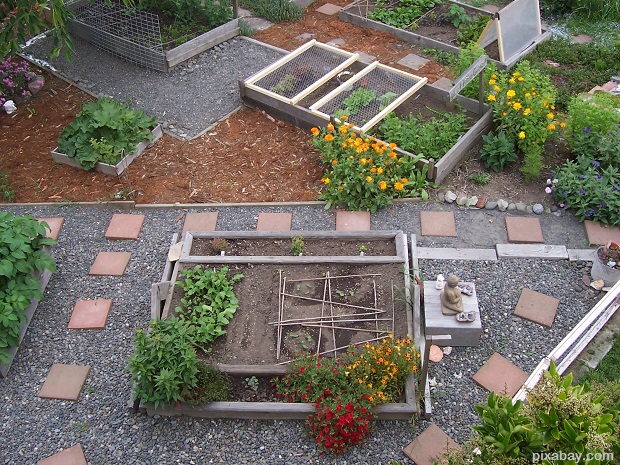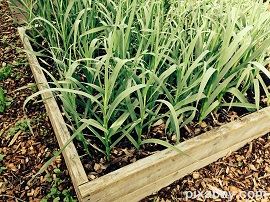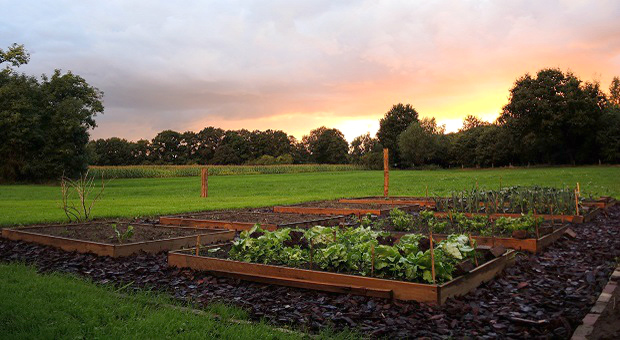There are many reasons why raised bed gardening is becoming so popular. One of the main reasons that they’re great for people who don’t have a lot of room is because you can put more plants in a raised bed than you could in a garden, thus making the most of what space you have.
The boxes are filled with dirt and compost that you control, so you can feed your plants exactly what they need to grow and flourish instead of depending on local soil. Raised beds maximize water usage so you grow more even in drought conditions and if you live in a wet climate, excess water can drain better. Soil erosion or compaction aren’t issues, either.
Since raised beds warm faster than the ground, your growing period is longer than if you had a traditional garden.Because the conditions are so controlled, raised bed gardens are much more forgiving for beginning gardeners and are easily tended by those with more experience. Snails and other pests have a tougher time reaching raised beds, too.
Finally, let’s not forget the strain that it takes off of your body. Raised beds won’t require as much bending because they’re built higher and, since they repel weeds, you won’t have to spend time bent over tending your garden.
But where should you start if this is your first time? Should you avoid any practices and are there tricks that can increase your odds of success? That’s what we’re going to discuss today!
Are planters and raised gardens the same?
This is a question that we hear a lot and seems to cause serious confusion among first-time raised-bed gardeners. The answer is a resounding “no”. The primary, and significant, difference between raised bed gardens and planters is that planters have built-in bottoms and raised bed gardens don’t.
This is a significant difference because the lack of a bottom allows the roots of the plant to grow as deeply as they need to in order to anchor the plant and obtain the nutrients that it needs for survival. Imagine trying to grow a carrot in a planter – you wouldn’t have much success, right?
What types of wood should you build raised bed gardens?
Without a doubt, wood is the most commonly used material in the construction of raised beds but you need to be careful. Don’t use wood that’s been treated with toxins such as railroad ties that have been soaked in creosote. You don’t want that to come into contact with your food.
Although the EPA says that the chemicals used to pressure treat lumber (alkaline copper quaternary, aka ACQ and copper azole, aka CA-B) is safe to use for growing food, as recently as 2003, a toxic chemical called chromated capper arsenate (CCA) was used so if you’re using reclaimed wood that is that old, you may be unintentionally mixing arsenic into our soil.
I personally avoid pressure treated lumber in my raised beds because it’s a chemical and I wouldn’t drink it. In my mind, that means that I shouldn’t grow my food in it. According to sources that I found, treated lumber isn’t permitted to be used in commercial organic gardens or else the food isn’t considered organic. I guess it’s fine to use for ornamentals, though. It’s a personal decision so make your own call.
There’s also a concern about using recycled pallets, not because of the chemicals that they’re treated with but because you don’t know what they’ve been in contact with. Remember, pallets are used to hold everything from cases of rat poison to boxes of raw chicken and they have been shown in a lab setting to harbor everything from bird poop to E. coli. You may want to skip pallets if you’re growing food.
If you want to play it safe, use untreated lumber. Woods less prone to rot are great because you’ll get longer life from your beds but they can be costly, too. Redwood, cedar and Jupiter are all woods that are rot-resistant if you’re interested in going that way.
Is concrete safe to use to build your raised beds?
This is a question that’s been cropping up more often since people started making those extremely efficient beds out of concrete blocks, aka cinder blocks. The argument here is that concrete contains chemicals and cinder block is often made from fly ash, which you wouldn’t want around your food.
The truth of the matter is that, though concrete dust is hard on your lungs and there are chemicals used in the production of some concrete, the actual ingredients of standard concrete are benign. Though “cinder block” is used in most parts of the country as a synonym for a concrete block, they aren’t actually made from cinders any more.
I couldn’t find any solid evidence from a single credible source that says that concrete is harmful if it comes into contact with your food plants so I’ll continue to use it.
If you make the same decision, be careful about adding chunks to your soil because concrete is alkaline and you may unintentionally affect the pH of your soil. I don’t think this is much of a concern if you’re using concrete block as your structure though.
Using other materials
Modern technology has blessed us with plastic and composite materials that we can use to make fake boards. HDPE (High density polyethylene) is the plastic that’s usually used to make these and it’s a non-leaching material most often made from recycled milk jugs. It’s a lot more durable than wood.
Though I’m typically against using store-bought anything, especially plastic, if I can avoid it, I’d possibly consider using these because they actually support recycling.
Other materials that are good to use include logs and stacked sand bags. Really, you can use whatever you want; they ‘re your beds. Just watch out for materials that may leach toxins into your soil.
How tall should your raised garden beds be?
This is a question with about a thousand answers but they’re all a variant of “however tall you want them or need them to be.” Obviously taller beds are going to require more dirt and compost. The only reasons that you would want to go much higher than 12 inches, which is the average height of a raised bed, is if the soil underneath your bed is bad and you don’t want to dig or if you want them to be taller so that you don’t have to bend as much.
Keep in mind that if you go taller than 18 inches or longer than 6 feet, you should probably reinforce the sides of the bed with braces so that the wood doesn’t bow out and distort the shape of the box or let your dirt escape. Use cross supports ever 4-6 feet to prevent this from happening.

Remove roots from the soil when digging your raised bed
You want to prepare the soil underneath your raised bed garden carefully before you build your bed over it. Remove any roots that you find because they’ll leach the nutrients out of the soil before your plants have a chance to get to them.
You’ll want to dig down about 16 inches and turn the soil well, removing any rocks as well as roots while you go. Layer the soil up the sides so that you have a trench to put the soil in.
Level the soil under the bed first
This may sound silly because you’re just going to pour your own dirt and compost in there, right? Well yes, but the soil is going to settle a bit after a few waterings and you want them to do so on the level so that your bed settles level instead of listing one direction or another.
Use a level for this because you’d be surprised by the difference that just a couple of inches make. You may want to add your soil, water it, then let it settle for a few days before planting anything in it just to be sure you’re good.
Build the long side of the bed facing south
No, we’re not just doing this to give your beds a room with a view. Well, yes we are, sort of. If you put the long side of the bed facing south, your plants will be getting even exposure to sunlight which will help them to grow efficiently and equally.
Account for moles and other burrowing pests
If you live in an area that has a healthy mole population, you may want to consider lining the bottom and sides of your bed with hardware cloth, which is a metal mesh. If you’re planning on growing root crops, just dig a little deeper so that they have room to grow.
Don’t walk on your beds
One of the best benefits of a raised bed garden is that the soil doesn’t become compacted. If you walk on it, you’re compacting the soil which will inhibit root growth because you’ve decreased aeration in the soil. Nothing with any weight should ever enter your raised bed garden, including pets and even buckets with anything heavy in them.
It may be helpful to build a spanner board along the edge of your bed to kneel on or to set you buckets on. This is just a board that runs the length of the bed but is laid flat across the top of the bed so that it acts as a shelf.
Be careful using mulch between your beds
 The only reason I mention this at all is because I hate weeds and have learned that sometimes mulch contains weed seeds. The reason that I typically use mulch is so that I don’t have to weed between my beds but if the mulch comes pre-seeded, that kind of defeats the purpose.
The only reason I mention this at all is because I hate weeds and have learned that sometimes mulch contains weed seeds. The reason that I typically use mulch is so that I don’t have to weed between my beds but if the mulch comes pre-seeded, that kind of defeats the purpose.
Ask the dealer if they know anything about this or have received any complaints if it matters to you. It really isn’t a big deal but I thought it was worth mentioning.
What is a root barrier and do you need one?
First, let’s explain why roots are bad. The roots of trees and shrubs are attracted to the moisture and nutrients in your raised beds and will grow to them, sucking the nutrients out of the soil before your plants can get them. Now, what’s a root barrier and do you need one?
A root barrier is built between the trees and your raised bed gardens by digging a trench 4-6 feet deep and lining it with roofing metal or the like so that the roots can’t reach your beds. If you’re building serious beds that you plan to use for a long time, then you may want to do this.
If it’s just a hobby, you don’t need to unless you just want to. Try to put your beds far enough away from trees or shrubs that this won’t be an issue.
What are some standard measurements?
These are your beds so you can build them however you want but you need to make sure that you can reach the center of the bed without walking on the soil and you need to make sure that your spot has the right amount of sunshine.
Standard raised beds are 4-6 feet wide by 8-12 feet long. You need to allow plenty of room to put that rich, nutritious soil in, so make the sides at least 12 inches tall and break up the soil at the bottom at least 6 inches down, and preferably 12-16 inches down, before you add the dirt so that you get proper aeration and can remove rocks and roots.
Trellises are awesome
If you’re planting vining plants such as tomatoes, save space and veggie rot by adding some trellises into your raised beds. Trellises can be as simple as using wooden stakes or actual pieces of trellis buried into the soil. As the plant grows, feed them up the trellis, tying them loosely as they grow. This will increase your yield and also make it easier to trim the sucker leaves off of your plants.
Raised bed gardens are as unique as the person who builds them. They’re awesome for both experienced gardeners and newbies alike and are a great way to grow your own food in limited spaces. You’ll probably make a few mistakes and have some growing pains as you learn, but that’s all part of becoming really good at it.
If you’re worried about survival, you’ll already be ahead of the pack if you have a garden started, even if it’s just a little one. Regardless of why you want to build your own raised bed garden, eating a fresh tomato from your own garden will be well worth the effort!
If you have anything to add, please feel free to do so in the comments section below.
This article has been written by Theresa Crouse for Survivopedia.











































































Two other woods not mentioned that are great for raised bed gardens are black locust and larch (tamarack). Black locust will outlast treated lumber 2 to 1 and larch is about equal to pressure treated. Honey locust does not have the rot resistant properties as black locust does and should be avoided for this purpose. With these two woods it is best to build when the lumber is still green because black locust is as hard as a rock when seasoned. Larch has a tendency to split like hemlock when seasoned.
I have a few banks that are a pain to mow, weed, etc. I would like to turn at least 1 of these banks into raised “waterfall” garden beds. Any suggestions?
My USFD trail boss cert had us building trails along desert mountains. We would cut into area above and pull soil down to the trail area. You may be able to get by without forms. It will take some planning. It won’t be easy.
We once built a terraced garden on a steep hillside that sloped down to a river. We built it out of river rocks and cement and made each terrace with a path for me to tend to the next terrace up. Some of the plants had a waterfall effect because they draped over the rock wall and into the path on the next terrace down. The rock wall was about 8 inches thick and about 3 to 4 feet high. The garden was very productive. The walls were still in good condition 5 years later. We had to move. But I am pretty sure that those walls are still standing, 9 years now.
Two things. I plant facing East. That way the sun is able to travel down the rows to light up the plants and tall plants don’t block the sun. Season lumber is a no, no. You are warn to wash your hands after handling it and avoid breathing the wood dust while cutting. You use to get a warning sheet from the lumberyard concerning treat lumber. I wouldn’t trust it. Best to buy 2×12 and paint it with a couple of coats of enamel paint. It will last years. Just my 2 cents.
The picture with the article shows large leafy plant, like lettuce. Your wasting time and money, and room. You can buy leafy plants cheaper at the store. Growing high cost veggies makes more sense.
I have room for a very large garden, right now its 20′ wide by 40′ long , my in laws are in on it with me and my wife. We have been having a lot of problems with blite so we think, so the in laws have decided they think raised gardens will help esp. if we put a weed barrier under neath the beds and bring in new soil, I am not convinced this will work or that only 12″ of soil will be enough , what do you all think any help would be great.
12″ are fine for radishes, leaf lettuce and maybe even peas or beans, but I don’t think you’ll be growing anything large like corn or watermelon nor anything that likes to run deep like potatoes or beets.
I started with two raised beds about 6’x8, each and used 2″x 8″ double stack for a rough height of 16″ I removed grass, dig about 12″ down just to clean and loosen up base soil, good compost and soil mixture to a depth of 12′ to 14″ with about 4″ from soil to top of boards. I the next year I made wood frame panels and plastic to fit over the top of each bed that know becomes two greenhouses?! This I highly recommend doing once you get a raised bed going.. I now start sowing seed in late winter and once spring arrives I just remove panels till fall for frost protection, no root shock, very easy to maintain compared to row gardens. Final note I used part of one bed for sowing flower seed and plants, sky’s the limit, honestly with my experience I realized how much more fun gardening became because they were less work to get excellent results!